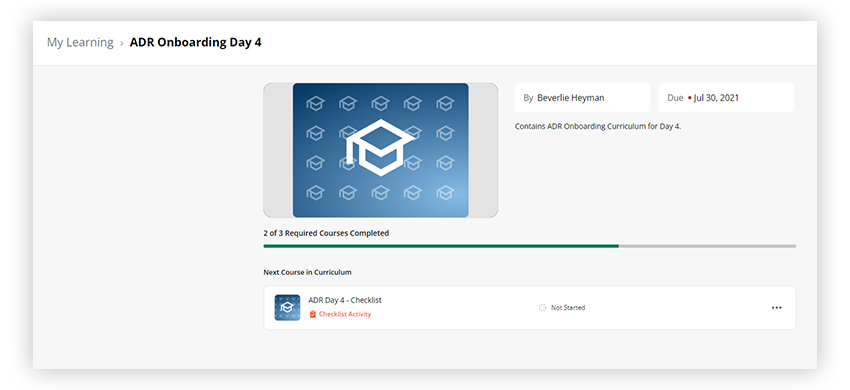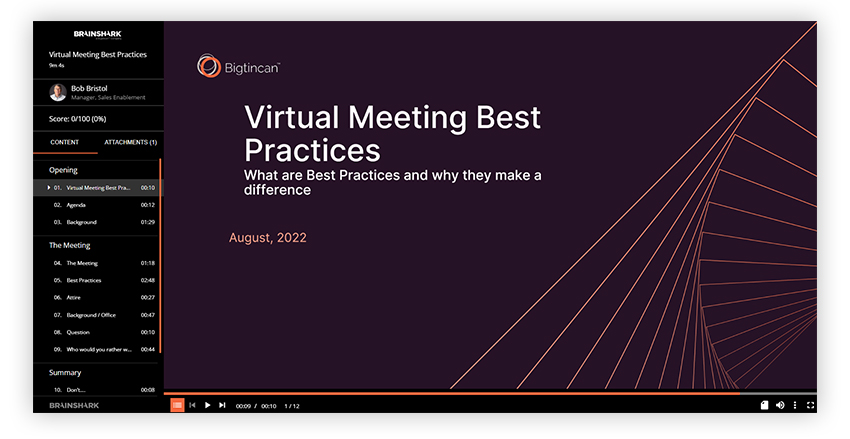Organizations looking into employee education programs, professional development tools like sales enablement software, or learning management systems (LMS) often wonder whether formal or informal learning, or some blend of the two, is right for their teams.
Before making this decision, it is important to understand the difference between formal and informal learning and how they can each benefit different organizations depending on their goals.
Formal vs. informal learning
Formal learning is structured, typically led by instructional designers and trainers in a classroom setting. It is what most people traditionally think of when they think of training. Informal learning, on the other hand, has no formal structure or curriculum, offers more flexibility for learners, and can often be accessed on-the-go via mobile devices. Though these days, any type of learning done on a mass scale across the enterprise will involve software.
Related: The Best Enterprise LMS 2.0 for Training and Knowledge Retention
However, it’s important to understand that there are many different opinions out there on formal vs. informal learning, and there’s certainly more than one approach for each.
At Brainshark (a Bigtincan company), we believe the training experience you choose should depend heavily on your organization’s needs, objectives, and challenges. In his book, Informal Learning: Rediscovering the Natural Pathways that Inspire Innovation and Performance, Jay Cross likens the difference between formal and informal training to riding on a bus vs. riding a bike:
- With the formal learning bus analogy, “The driver decides where the bus is going; the passengers are along for the ride.”
- As for the informal learning bike comparison, “The rider chooses the destination, the speed, and the route.”
To understand better, let’s take a closer look at two different approaches for enterprise employee training.
What is formal learning?
Formal learning programs typically include specific courses and curricula mapped in a very structured way that must be delivered and consumed on a specific timetable, such as an onboarding curriculum targeted to a specific audience or cohort.
As a result, content is generally created and delivered by a specified group of instructional designers and trainers, such as sales enablement leaders, in a “top-down” approach.

ADR onboarding curriculum developed by Bigtincan sales enablement leaders
The content development process usually lasts longer with formal learning programs, as those involved are often tasked with creating thorough presentations and courses and publishing them via a potentially more complex platform.
Content and learning materials can be delivered via a traditional classroom or group training model (whether in-person, virtual, or a hybrid of both) complete with lectures, required reading and/or tasks, and scheduled testing or assessments.
With so many organizations shifting to a full-time remote workforce, live webinars and screen-sharing technology can be used so remote learners can complete the required sessions.
Who should use formal learning?
Formal learning is a popular choice for organizations who wish to have more control over the learning experience of their employees or for delivering specific types of course material or certifications.
Hospitality, education, healthcare, and manufacturing are examples of industries that should include formal learning scenarios in their professional development programs, such as more tactile safety or skill trainings.

A CPR certification, for example, would require an in-person formal learning session to teach the technique, with virtual assessments and follow ups conducted through learning software as needed.
Formal learning often includes:
- Courses
- Curricula
- Certifications
- Classrooms (physical or virtual)
- Assigned tasks, reading, or assessments
- A blend of long and short-form content
What is informal learning?
Informal learning, on the other hand, provides a lot more flexibility in the way content is both created and consumed.
Informal learning sessions are usually unscheduled and happen by design or by chance according to each individual learner or employee— and aren’t graded! They may have quizzes built in to help reinforce knowledge, but they don’t have the same stakes as formal learning assessments.
They are usually shorter sessions (often called microlearning) used for a quick refresher on a topic like company policy, product info, or best practices, or a short demo of a specific task, like how to use a feature in an application the organization uses. In many cases, employees or organization members are encouraged to contribute to informal learning content by uploading their own videos, slides, or documents.

A lot of professional development these days is self-driven. When faced with a question, employees will seek out answers wherever they can — a search engine, their peers, or the company’s learning platform. Organizations can continue to foster this behavior by providing ways for members to quickly create and deliver content in a way that makes sense.
The idea behind informal learning is that rather than limiting the responsibilities of content development to a few instructional designers, subject matter experts from across the organization can now become part of the process. Since anyone can create learning resources quickly and easily, more content can be developed by those who best understand the needs of the learners.
While both formal and informal learning programs are capable of delivering content quickly on-demand, informal learning is by nature generally more convenient for the audience. Think of it as ready-when-you-are (also known as just-in-time) training, opposed to a formal onboarding program that must be completed in a timely fashion and is built around the instructor’s schedule.
Informal learning allows companies to save time on tedious live training sessions which tend to cut into employee productivity. It’s also easier to segment the audiences for on-demand content, meaning learners can choose the information they care most about and access it as needed, rather than sitting through mass live training sessions where the topics covered may not always be relevant.
Informal learning consists of:
- Microlearning
- Just-in-time learning
- Short-form content
- Continuous reinforcement
- Self-driven development
- An internal knowledge base
Related: Make your content make SENSE — best practices for creating and managing sales enablement content
Who should use informal learning?
Informal learning works best for medium to large enterprises with distributed, remote, or hybrid workforces who want to foster peer learning and offer convenient professional development options to their employees.
Moreso than formal learning, informal learning caters to remote teams.
The bite-size content can easily be consumed, shared, and distributed via an internal knowledge base or through messaging apps like Slack or Microsoft Teams. In other words, a well-developed informal learning program provides information to learners anytime, anywhere.
Customer-facing employees like sales and customer service reps in retail, software, technology, insurance, financial services, and pharmaceutical industries all use informal learning to great effect. Here’s one example from Allurion, a global healthcare company.
Formal vs. informal learning: how to decide
Each organization’s challenges are unique and therefore their training programs should be too. What it really comes down to is your company’s specific needs and how a formal and/or informal learning program can best help. For example:
- Content Development – How complicated is it to create and deliver new content? Is it difficult to leverage the expertise of others in the company? Do you have trouble getting timely messages out quickly? How often does certain content need to be updated?
- Audience – Are live formal training sessions wasting too much time? Are the sessions having the desired effect? Do learners have trouble finding follow-up information when they need it?
- Tracking and Reporting – How many people need to generate reports? Do you need more or less control over required courses? What exactly do you need to track?
Now that you know the difference between formal and informal learning, it is time to get started building a catered program for your organization. Just remember, when developing your company’s training strategy, iron out your needs and objectives first, then choose the program that makes most sense for your unique challenges. Many often find a blended learning approach of both formal and informal training is the right way to go.
Additional resources:
- 18 Indicators you could benefit from a modern sales learning platform
- The Essential Guide to Sales Enablement
- How to Train a Sales Team on Products: Use Modern Software, Not Old-Fashioned Training Techniques
What’s the difference between formal and informal learning and who should use which? Get a complete overview with examples here.
